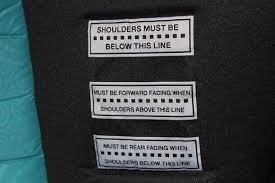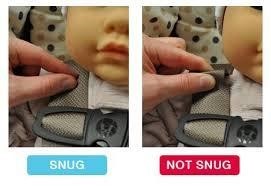There is lots of solid research both here in Australia and from overseas that shows that unfortunately, the rate of misuse of child car seats is very high.
“A 2010 study of 503 children from newborn to the age of 12 found half of all restraints had errors in how they were used. Some had up to seven errors each, ranging from failing to buckle the child in to slackness in the belts and sashes. Most often parents weren’t aware they had made a mistake.”
http://www.smh.com.au/national/health/errors-in-child-car-seat-use-putting-lives-at-risk-experts-warn-20170518-gw894a.html
When we arrive at a baby shop, instinctively we will gravitate to either a label or logo we recognise, or a colour we like. However choosing the correct product for your child is much more complex than that.
The following information is general and we strongly encourage you to read fully the instruction manual that relates to your particular make and model of child restraint.
Choose the correct type of restraint for your child
Ensure that the seat you are considering is the right size for your child and that it meets Australian Standards and has the Australian Standards logo sticker present.
Contrary to popular belief, Australia’s Standards for car seats are in fact among the toughest in the world ensuring the best possible protection for our children on the road.
In Australia it is illegal to purchase or use a car seat that does not comply with the Australian/New Zealand Standard 1754 – even if you’re visiting. Always look for the certification mark AS/NZS:1754 on the car seat you choose for your child.
Choose for the childs size not by their age
Seats are not graded by age of children but by their size. The size of children can vary – two 4 year olds can be entirely different heights and weights so check that your child’s fits within the shoulder height marker label for the specific model of car seat you are considering. Just like when you’re buying jeans – you take your legs with you to ensure the product fits so take your child with you to test the restraint does in fact fit them.
The laws are the minimum
The road laws relating to kids and cars are minimums. We don’t aim for the minimum safety – but for the maximum. So keep your child in their restraint for as long as they still fit in it. When your child reaches 6 months that doesn’t mean its time to turn them forward facing. Just because they turn 3 you don’t put them in size 3 shoes – if the seat still fits – keep using it.
Use their age as a guide only.
- Children under the age of six months must use a rear facing car seat
- Children aged six months to four years can use either a rear facing car seat or a forward facing car seat.
- Children aged four years to approximately seven years must travel in a forward facing car seat or booster seat.

Use the shoulder height marker labels – that’s what they’re there for
Newer seats nowadays all have a label on the restraint showing you exactly where the child’s shoulders can be to safely use the seat. Shoulder height markers make it so easy for carers to establish if a child car seat is suitable for their child and when the child needs to have the shoulder straps adjusted or when they are ready to move to the next child car seat.
Shoulder Height Markers, located on the inner side of the seat, prompt parents and carers to ensure their child’s seats, and associated harnesses, are adjusted at the right stages of the child’s growth to maintain optimal safety in the event of an accident.
Your child should remain in a rear facing seat or position until their shoulder is in-line or above the forward facing height marker.
Your child should remain in a forward facing seat until their shoulder height is above the upper shoulder height marker.
Note: There is a slight difference between rear and forward facing and that relates to the dynamics in the event of a collision.
Ensure your restraint is installed correctly
We don’t necessarily believe that you require professional installation of your restraint however there are a lot of belts, buckles and pathways to contend with. Before you begin, ensure you have read the instruction manual for your restraint in full and be confident that you understand how to install your seat. If you are uncertain please don’t hesitate to contact us or a local restraint fitting station for advice.
Unfortunately there is a lack of understanding around the power of collision dynamics and there is an idea in the community that a car seat must be ‘rock solid’ post-fitment to be safe. This is incorrect. The Australian Standard testing procedures that these products are subjected to are stringent and demanding.
The more rigidly a restraint is attached to the vehicle chassis, themore collision force the infant will be subject to. Imagine if you will the catching arm of a cricket player. If it were completely rigid and unmoving it would shatter into pieces – exactly the same with carseats. Even the new rigid ISOFIX seats have a hinge that allow for some up and down movement to counter this possibility.
Overtensioning a restraint when installing it can cause stress damage to both the restraint and/or the vehicle seats unecessarily. A restraint that is fitted correctly does allow for some movement but no more than 2.5 cms from side to side at the belt path end of the restraint. Shaking your restraint around at the top end (where the top tether begins) is not an accurate test of correct fitment and will do nothing but loosen your restraint and perhaps leave the seat requiring refitment.
Use the top tether and harness straps correctly
We have had customers return capsules or carseats and inform us that they didn’t use the top tether because it was annoying or took up too much time to deal with. Please – use the top tether. In an accident it serves as a very important tool to minimise the possibility of your child being injured in the crash.

When you are using the inbuilt harness ensure that the shoulder straps are:
- at the correct height for your child
- there are no twists in the harness that is on your child. Twists here can cause significant injuries so ensure at every use that there are no twists in the harness
- fitted firmly with no slack (a good way to test is to try and pinch the belt together. If you can’t pinch any fabric it is firm enough).
Keeping our list of tips in mind will help you to make a the right choice. If you have any concerns about child car seat use or how to choose please don’t hesitate to contact our Team who are well able to assist you.
